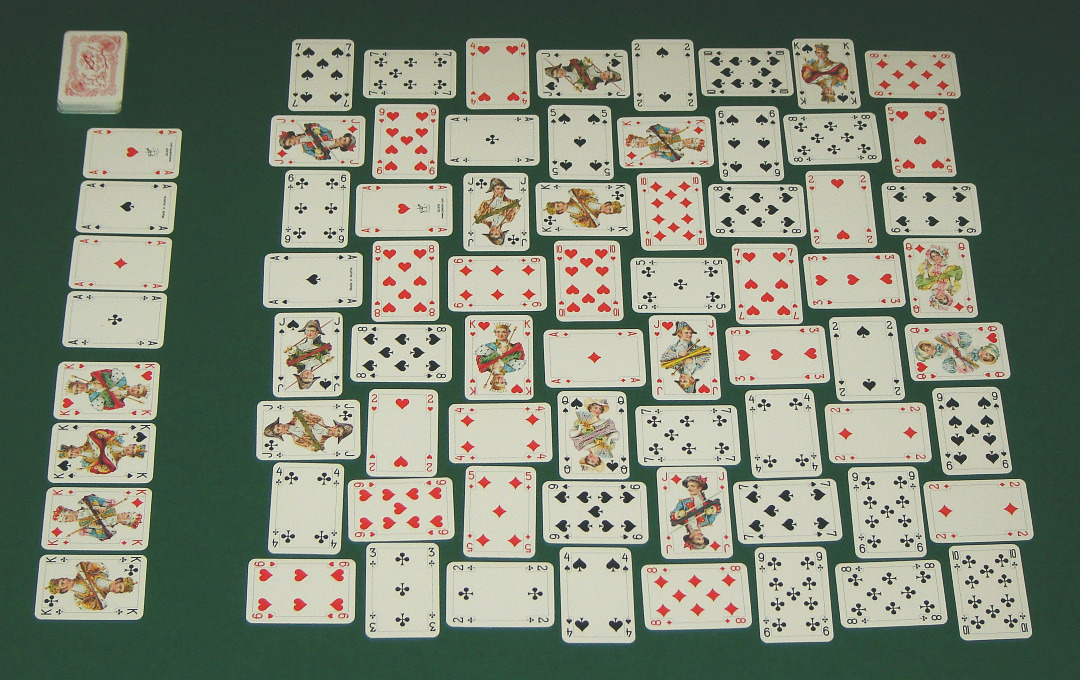|
American Toad (solitaire)
American Toad is a solitaire game played using two decks of playing cards. This game is similar to Canfield except that the tableau builds down in suit, and a partial tableau stack cannot be moved (only the top card or entire stack can be moved). The object of the game is to move all cards to the foundations."Toad" in George Hapgood, ''Solitaire and Patience''. Rules Layout American Toad has eight tableau stacks. Each tableau stack contains one card and builds down in suit wrapping from Ace to King, e.g. 3♠, 2♠, A♠, K♠... Eight foundations build up in suit, e.g. 7, 8, 9... The game includes one reserve pile with twenty cards that can be played onto the tableau or foundations. A deck usually at the bottom right turns up one card at a time. File:American Toad (solitaire) Layout.jpg, American Toad Layout Gameplay One card is dealt onto the first foundation. This rank will be used as a base for the other foundations. The foundations build up in suit, wrapping from King t ... [...More Info...] [...Related Items...] OR: [Wikipedia] [Google] [Baidu] |
Solitaire
Solitaire is any tabletop game which one can play by oneself, usually with cards, but also with dominoes. The term "solitaire" is also used for single-player games of concentration and skill using a set layout tiles, pegs or stones. These games include peg solitaire and mahjong solitaire. The game is most often played by one person, but can incorporate others. History The origins of Card Solitaire or Patience are unclear, but the earliest records appear in the late 1700s across northern Europe and Scandinavia. The term ''Patiencespiel'' appears in ''Das neue Königliche L’Hombre-Spiel'', a German book published in 1788. Books were also reported to appear in Sweden and Russia in the early 1800s. There are additional references to Patience in French literature. In the United States, the first card solitaire book, ''Patience: A series of thirty games with cards'', was published by Ednah Cheney in 1870. The most popular card solitaire is Klondike, which was called Microsof ... [...More Info...] [...Related Items...] OR: [Wikipedia] [Google] [Baidu] |
Canfield (solitaire)
Canfield (US) or Demon (UK) is a patience or solitaire card game with a very low probability of winning. It is an English game first called Demon Patience and described as "the best game for one pack that has yet been invented". It was popularised in the United States in the early 20th century as a result of a story that casino owner Richard A. Canfield had turned it into a gambling game, although it may actually have been Klondike and not Demon that was played at his casino. As a result it became known as Canfield in the United States, while continuing to be called Demon Patience in the United Kingdom and elsewhere. It is closely related to Klondike, and is one of the most popular games of its type. History The game is first recorded in 1891 in England by Mary Whitmore Jones as Demon Patience. She describes it as "by far the best game for one pack that has yet been invented," and goes on to say that its "very uncomplimentary name" seems to derive from its ability to frust ... [...More Info...] [...Related Items...] OR: [Wikipedia] [Google] [Baidu] |
Glossary Of Solitaire Terms
Games of patience, or (card) solitaires as they are usually called in North America, have their own 'language' of specialised terms such as "building down", "packing", "foundations", "talon" and "tableau". Once learnt they are helpful in describing, succinctly and accurately, how the games are played. Patience games are usually for a single player, although a small number have been designed for two and, in rare cases, three or even four players. They are games of skill or chance or a combination of the two. There are three classes of patience grouped by object. The most frequent object is to arrange the cards either in ascending sequence (e.g. from Ace to King) or descending sequence. Occasionally both forms of sequence are aimed at in the same game. The card forming the starting point of the required sequence is known as the foundation card and the sequence or family is said to be 'built up' on such card. In some cases foundation cards are picked out and placed in positi ... [...More Info...] [...Related Items...] OR: [Wikipedia] [Google] [Baidu] |
List Of Solitaires
This is a list of patiences, which are card games that are also referred to as solitaires or as card solitaire. This list is not intended to be exhaustive, but only includes games that have met the usual Wikipedia requirements (e.g. notability). Additions should only be made if there is an existing entry on Wikipedia that they can be linked to. To avoid duplicate pages being created, alternative titles and the names of variants are listed separately (except titles that include little more than the name of the parent game). Games of the patience genre played by more than one player are marked with a plus (+) sign. A * Accordion * Aces and Kings * Aces Square * Aces Up * Acme * Addiction * Agnes * Alaska * Algerian * Alhambra * Amazons * American Toad * Apophis * Appreciate * Acquaintance * Archway * Auld Lang Syne * Australian Patience B * Babette * Backbone * Baker's Dozen * Baker's Game * Baroness * Batsford * Beetle * Beleaguered Castle * Belvedere * ... [...More Info...] [...Related Items...] OR: [Wikipedia] [Google] [Baidu] |
Glossary Of Solitaire
Games of patience, or (card) solitaires as they are usually called in North America, have their own 'language' of specialised terms such as "building down", "packing", "foundations", "talon" and "tableau". Once learnt they are helpful in describing, succinctly and accurately, how the games are played. Patience games are usually for a single player, although a small number have been designed for two and, in rare cases, three or even four players. They are games of skill or chance or a combination of the two. There are three classes of patience grouped by object. The most frequent object is to arrange the cards either in ascending sequence (e.g. from Ace to King) or descending sequence. Occasionally both forms of sequence are aimed at in the same game. The card forming the starting point of the required sequence is known as the foundation card and the sequence or family is said to be 'built up' on such card. In some cases foundation cards are picked out and placed in positi ... [...More Info...] [...Related Items...] OR: [Wikipedia] [Google] [Baidu] |
Double-deck Patience Card Games
A double-decker is a vehicle that has two levels for passengers or cargo, one deck above the other. Such vehicles include: * Aerial tramway * Bilevel rail car a rail passenger vehicle consisting of 2 levels * Bombardier BiLevel Coach * Bombardier MultiLevel Coach * Dome car * Double-deck aircraft * Double-deck elevator * Double-decker bus * Double-decker tram * Superliner (railcar) * Autorack (US) or car transporter (UK), a railway vehicle for transporting cars or other road vehicles * Car carrier trailer or auto carrier, a road trailer for transporting cars or other road vehicles * Two-decker is a sailing ship with 2 decks armed with cannon. A double-decker may also refer to: * Double Decker (chocolate bar) Double Decker is a British brand of chocolate bar currently manufactured by Cadbury. First introduced in the UK in 1976, its name derives from the well-known double-decker bus, with the buses themselves sometimes appearing in advertisements for ... * Double-decker s ... [...More Info...] [...Related Items...] OR: [Wikipedia] [Google] [Baidu] |
Mobile Games
A mobile game, or smartphone game, is a video game that is typically played on a mobile phone. The term also refers to all games that are played on any portable device, including from mobile phone ( feature phone or smartphone), tablet, PDA to handheld game console, portable media player or graphing calculator, with and without network availability. The earliest known game on a mobile phone was a Tetris variant on the Hagenuk MT-2000 device from 1994. In 1997, Nokia launched ''Snake''. Snake, which was pre-installed in most mobile devices manufactured by Nokia, has since become one of the most played games and is found on more than 350 million devices worldwide. A variant of the ''Snake'' game for the Nokia 6110, using the infrared port, was also the first two-player game for mobile phones. Today, mobile games are usually downloaded from an app store but in some cases are also preloaded in the handheld devices by the OEM or by the mobile operator when purchased, via inf ... [...More Info...] [...Related Items...] OR: [Wikipedia] [Google] [Baidu] |




